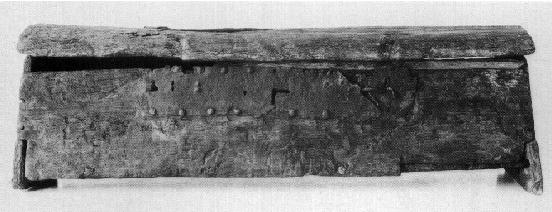
Figure. 1. A frontal view of the original Mästermyr chest.
| A Replica Viking Chest, based on the Mästermyr
Find
By Stephen Francis Wyley Drawings by Steven Lowe |
|---|
Stephen Wyley
18th June 2002
| Introduction | Background | The Drawings | Notes on construction of the chest itself | Some other chests of interest | Bibliography | Footnotes |
Other Viking articles by the same author |

Figure. 1. A frontal view of the original Mästermyr chest.
This is not another "How to" article, it's more a "How it was done" article. I have included the drawings and pictures of the nearly complete replica. I hope to have the lock plate completed and attached in the near future. Also included is some information on other extant Viking chests for your further consideration.
Rather than plan and construct the replica myself I decided on obtaining the aid of experts in their field. This procedure produced a lovely replica but the final cost would be prohibitive to most re-enactors. Therefore in this article I hope to help other people make their own replicas by providing the drawings, pictures, hints on construction and information regarding other chest. Pictures of the completed replica can be seen Figure 4. and Figure 5.
I would like to take this opportunity to thank; Steven Lowe (Draftsmen),
Natalie Vassililaka (Cabinet maker) and Steven Nicoll (Blacksmith) without
whom this project could not have been achieved.
"The chest was discovered in 1936 when (Hugo Kraft was 1 ) ploughing what was a, in the Viking age, a lake, the chest was encircled by an iron chain. It contained the largest collection of tools of this date so far found: iron working and carpenter's tools, raw materials, un-finished products."2
The Mästermyr chest is made of oak, 86.0 - 88.5 cm in length and dates from 1000 A.D. Currently the find is housed at the Statens Historiska Museum in Stockholm, Sweden, ref no. 21592.
Greta Arwidsson gives a wonderful description of the oak chest:
"Chest of oak with lock and hinges of iron. The chest is rectangular with a lid curved in cross section and a flat bottom. The bottom is joined to the ends by mortice and tenon joints. The chest is held together by wooden pegs at the ends and sides. The ends and sides are trapezoid and therefore slope inwards at a slight angle. The ends, which are made of a slightly thicker scantling than the sides and bottom, have a rectangular mortice about 4 cm from the lower edge for the tenons of the bottom plank. The lower portion of each end thus forms a raised base.
The ends, sides, bottom and lid each seem to have been made from a single piece of wood. The underside of the lid is hollowed out, leaving an oval, trough-like depression. On either side of the depression the underside of the lid is flat, where the original thickness of the plank has been preserved; this provides a good fit against the upper edges of the end planks.
The sides are pegged to the ends and the bottom and the bottom is joined by mortice and tenon to the ends; a rectangular tenon at each end of the bottom plank fits into a mortice in the ends...
...The iron fittings on the chest consist of a large lock-plate and
two hinges..."3
According to the cabinet maker Natalie there were a number of details which were of note:
the bottom had to be slid into one of the mortice and tenon joins first then the sides attached before the final end was attached, or the bottom could not be put in place, see Figure 3. ; the dishing out of the depression on the under side of the lid was very arduous by hand; the bottom, sides and ends need to glued into place before the holes for the dowel are drilled.
Steve Nicoll used real iron in the construction of the hinges and nails and it must be noted the iron is a difficult metal to work with at the best of times.
In 2001 I made chest base on the Mastermyr find but using smaller planks.
For this chest I made the hinges from flat mild steel (19mm wide). I attached
(using nails cleated over on the inside) the loop parts to the back first,
then attached the tanged parts to the top of the lid (again cleating the
nails). When the lid was place on the top of the chest with the hinge tangs
going through the loops the tangs were curled over the top of the hoop
parts using a ball pean hammer, tight enough to work but not to loose as
to rattle when the chest was moved.
No.1.
Oseberg, Sem, Vestfold, Norway, c. 800 - 850, length 66.5 cm, Universitetets
Oldsaksamling, Oslo, Norway, Oseberg 178. Simple flat lidded oaken chest
with trapezoidal front and back sections.
No.2.
Oseberg, Sem, Vestfold, Norway, c. 800 - 850, length 108 - 113 cm,
Universitetets Oldsaksamling, Oslo, Norway, K 68 5.
Curved lidded oaken chest with trapezoidal front and back sections, decorated
with iron bands with three rows of tinned nail heads.6
No.3.
Vox torp Church, Småland, Sweden, c 1200, Length 146 cm, Statens
Historiska Museum, Stockholm, Sweden, ref. no. 4094. A rectangular sided
chest with decorative ironwork.7
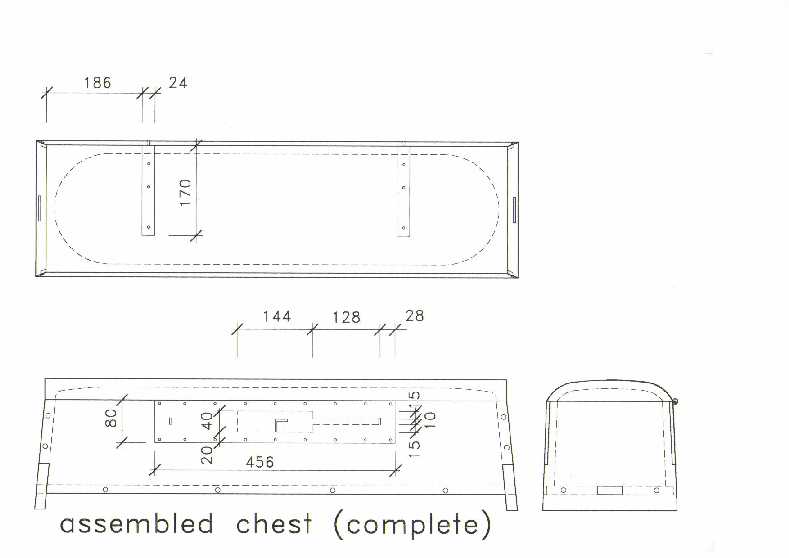
Click on the following for more detailed drawings:
|
|
|
|
|
|
|
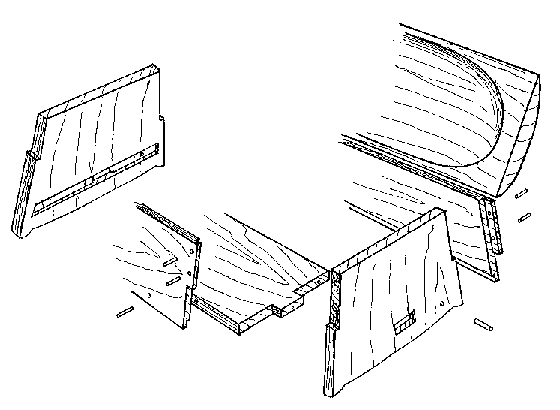
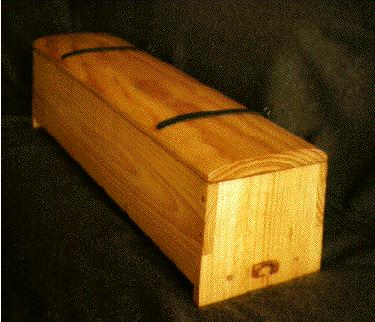
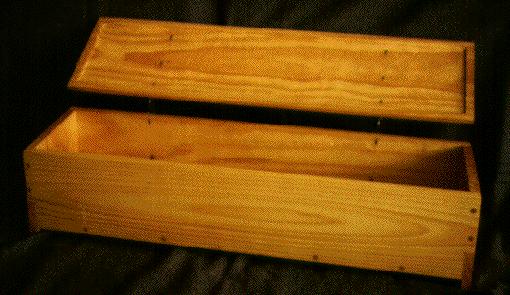
Almgren, B., et al, The Viking, New York, 1991.
Arwidsson, G. & Berg, G. The Mästermyr Find, A Viking Age Tool Chest from Gotland, Stockholm, 1983.
Graham-Campbell, J., The Viking World, London, 1980.
Graham-Campbell, J. & Kidd, D., The Vikings, London, 1980.
Roesdahl & Wilson, Eds., From Viking to Crusader, The Scandinavians and Europe 800 -1200, Sweden, 1992.
Wilson, D., Ed., The Northern World, London, 1980
1 Arwidsson, G. & Berg, G. The Mästermyr Find, A Viking Age Tool Chest from Gotland, Stockholm, 1983, p3.
2 Roesdahl & Wilson, Eds., From Viking to Crusader, The Scandinavians and Europe 800 -1200, Sweden, 1992, p251.
3 Arwidsson, G. & Berg, G. The Mästermyr Find, A Viking Age Tool Chest from Gotland, Stockholm, 1983, p.7. For more details on the lock and hinges I suggest you read the appropriate section on page 7 and 8.
4 Graham-Campbell, J. & Kidd, D., The Vikings, London, 1980, p 186. Another Viking chest is illustrated along with other finds from the Oseberg ship. This could be an artist's interpretation of chest no. 1. Roesdahl & Wilson, Eds., From Viking to Crusader, The Scandinavians and Europe 800 -1200, Sweden, 1992, p269, "Chests are common in both male and female graves in the Viking Age, but usually only the metal fittings are preserved", Irmelin Martens, Universitetets Oldsaksamling, Oslo.
5 There seems to be some confusion over the reference no. for this chest because according to Osebergfundet Volume 2 the reference number is Oseberg 164 were as it is listed as K68 in From Viking to Crusader.
6 Roesdahl & Wilson, Eds., From Viking to Crusader, The Scandinavians and Europe 800 -1200, Sweden, 1992, p 270. A third chest (No. 156) which was highly decorated was also found but had been robbed and destroyed in antiquity.
7 For other analogous chests I suggest you look at Osebergfundet Volume 2, pages 126 - 134.
How to make a replica of a Viking Table based on the Sala Hytta Find
How to make a replica of a Viking Toy Horse
The Gjermundbu Mail Shirt (The only extant Viking Mail Shirt)
The ‘Lund’ Viking Stool. A Method of Replication
| Copyright © Stephen Francis Wyley 1997 - 2002
svenskildbiter@angelfire.com |